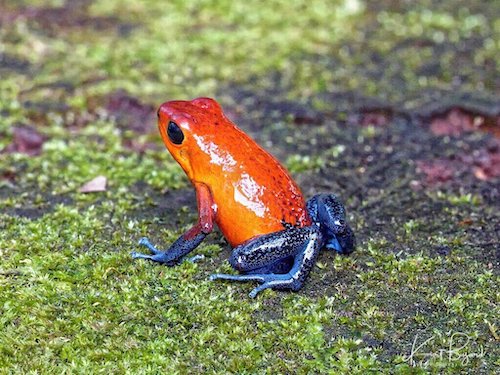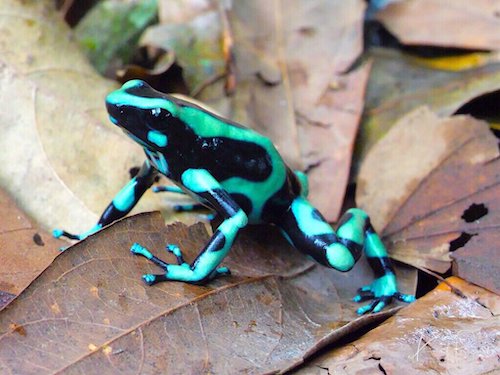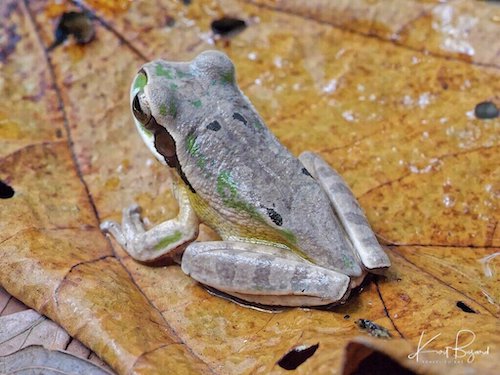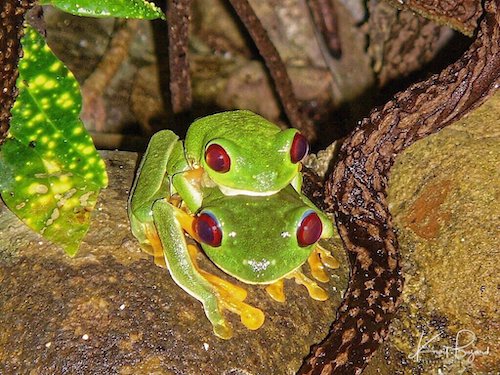
When I was in Costa Rica for a bird photography tour recently with Tropical Birding, I had an opportunity to visit Frog’s Heaven, a place that specializes in catching wild frogs for photography. The frogs are subsequently released back into the environment. These tiny frogs are getting harder to find, even in the optimized environments of the Frog’s Heaven preserve. Research suggests that even though amphibians are severely declining worldwide, there is no simple solution to halting or reversing these declines. Amphibians are good indicators of significant environmental changes. Amphibians, unlike people, breathe at least partly through their skin, which is constantly exposed to everything in their environment. Consequently, their bodies are much more sensitive to environmental factors such as disease, pollution, toxic chemicals, ultraviolet radiation, and habitat destruction. The worldwide occurrences of amphibian declines and deformities could be an early warning that some of our ecosystems, even seemingly pristine ones, are seriously out of balance. We were able to photograph a nice cross section of the different types of frogs which I thought I would present here.
Poison Dart Frogs

Poison Dart Frogs are the source for the famous poisoned blowgun darts of the Amazon jungles. A single “Golden Poison Frog” harbors enough poison to kill 10 grown men, making these frogs perhaps the most poisonous animals alive. Poison dart frogs all belong to the scientific family Dendrobatidae, which contains more than 175 individual species spread across a range that includes large parts of Central and South America. Although this clade is remarkably diverse, just seven kinds of poison dart frog reside in Costa Rica and only three of those species have the bright colors for which the family is most famous. The poison is a toxin they have on their skin, frogs produce it due to eating some insects which have the toxin. The body full of brilliant color works as an alert screaming “Hey! be careful, I’m poisonous”. The majority of Poison Dart Frogs are very small. Adults can be as small as 1.5 cm (0.59 in) but some can reach 2.4 inches (6 cm). Their average weight is 2 grams.
Blue Jeans Poison Frog



The Strawberry Poison Frog or Strawberry Poison-Dart Frog (Oophaga pumilio) is a species of small poison dart frog common throughout its range, which extends from eastern central Nicaragua through Costa Rica and northwestern Panama. The species is often found in humid lowlands and forest, but large populations are also found in farms and plantations. The strawberry poison frog is perhaps most famous for its widespread variation in coloration, comprising approximately 15–30 color morphs, most of which are presumed to be true-breeding. Though brightly colored and toxic, these frogs are relatively small, growing to approximately 0.69–0.87 inches (17.5–22 mm) in standard length. Females often lay unfertilized eggs in bodies of water where their tadpoles live, allowing the tadpoles to use the eggs as a source of nutrition. This unique behavior actually lends the species part of its scientific name, as “Oophaga” comes from the Greek word roots for “egg” and “eating.”
Green and Black Poison Frog


The Green and Black Poison Dart Frog (Dendrobates auratus), also known as the Mint Frog, inhabits the Pacific Coast of Central and South America, from Nicaragua and Costa Rica to Brazil and Bolivia. They have also been introduced in Hawaii. Adult Poison Dart Frogs are about 1.5 inches long. They are found near small bodies of water on the rainforest floor. It is one of the most variable of all poison dart frogs next to Dendrobates tinctorius and the Strawberry Poison-Dart Frog. Mating occurs between July and September, the rainy season in the rainforests where these frogs live. Females lay up to 6 eggs at a time in a pool of water. Eggs take two weeks to develop into tadpoles. When the eggs hatch, the male frog temporarily attaches the tadpoles to his back with a sticky mucus and then carries them to a lake or stream.
Tree Frogs

A tree frog is any species of frog that spends a major portion of its lifespan in trees. As the name implies, these frogs are typically found in trees or other high-growing vegetation. They do not normally descend to the ground, except to mate and spawn, though some build foam nests on leaves and rarely leave the trees at all as adults. Breeding might actually be a significant reason why tree-frogs spend most (or all) their lives on trees. In water puddles on leaves and plants there are no fish that can prey on eggs and tadpoles. Many tree frogs can change their color for better camouflage. Tree frogs are usually tiny as their weight has to be carried by the branches and twigs in their habitats. While some reach 2 to 3 inches (5–8 cm) or more, they are typically smaller and more slender than terrestrial frogs. Tree frogs typically have well-developed discs at the finger and toe tips.
Masked Tree Frog



The New Granada Cross-Banded Tree Frog (Smilisca phaeota) more commonly known as the Masked Tree Frog, is found in Colombia, Costa Rica, Ecuador, Honduras, Nicaragua, and Panama. Its natural habitats are both wet and dry subtropical or tropical forests, rivers, freshwater marshes, rural gardens, canals and ditches. The nickname of masked tree frog comes from the black or dark colored markings that start at their nose and go back along the face toward their ear, covering their eye. One of the unique characteristics of this frog is that it changes color from day to night. During the day it is tan, but at night it shifts color to green. I took this picture late in the day, just before dusk and you can see the color transformation starting. The Masked Tree Frog is one of the largest hylid frogs in Costa Rica growing to over 3 inches in length. Females lay their eggs in puddles of water which accumulate, covering the top of the water with a film of 2,000 eggs. Tadpoles develop quickly in the temporary pools and puddles, which are sometimes no more than a cattle footprint filled with water.
Mexican Tree Frog

The common Mexican Tree Frog (Smilisca baudinii) is a nocturnal species of tree frog whose native range extends from the Sonoran Desert and the Lower Rio Grande Valley of Texas south to Costa Rica. Common names include Mexican tree frog, Baudin’s tree frog and Van Vliet’s frog. They are usually found within lightly forested areas near permanent sources of water. Mexican tree frogs range in color from brown to green and can even change according to the circumstance. They always retain their classic pattern of dark patches that spreads across their backs and legs. A chunky frog with rather short legs, the Mexican tree frog is the largest tree frog found in the United States, with females reaching as large as 3.5 inches (90 mm).
Red-Eyed Tree Frog


In terms of appearance the Red-Eyed Tree Frog (Agalychnis callidryas) is the rock-star of frogs. These iconic rain-forest amphibians sleep by day stuck to leaf-bottoms with their eyes closed and body markings covered. When disturbed, they flash their bulging red eyes and reveal their huge, webbed orange feet and bright blue-and-yellow flanks. This technique, called startle coloration, may give a bird or snake pause, offering a precious instant for the frog to spring to safety. They are found in tropical lowlands from southern Mexico, throughout Central America, and in northern South America. Nocturnal carnivores, they hide in the rain forest canopy and ambush crickets, flies, and moths with their long, sticky tongues. Adult males are only about 2 inches (5 cm) in length while the females tend to be larger at 3 inches (7.5 cm).

During the mating season, the male frogs shake the branches where they are sitting to improve their chances of finding a mate by keeping rivals at bay. When rainfall is at its highest, a male red-eyed treefrog calls “chack” to get the attention of the female. During “amplexus”, the female carries the male on her back for several hours during the oviposition (fertilization and egg-laying) process. Amplexus is a type of mating behavior exhibited by some externally fertilizing species (chiefly amphibians and horseshoe crabs) in which a male grasps a female with his front legs as part of the mating process, and at the same time or with some time delay, he fertilizes the eggs as they are released from the female’s body. The female chooses a leaf above a pond or large puddle on which to lay her clutch of roughly 40 eggs. Since laying eggs generally occurs on both sides of a leaf, Red-Eyed Tree Frogs may fold the leaf to hide the eggs from predators. They also produce sticky jelly to glue the eggs together which may protect the eggs from splitting and dehydration.
Glass Frogs

Glass frogs are pretty remarkable creatures, named for the transparent skin on their belly, making their organs visible. Of the 150 species, many have transparent abdomens that give viewers a glimpse into their inner workings—intestines, heart and all. Glass frogs are arboreal, meaning they mainly live in trees, and only come out for mating season. Glass frogs are generally small, ranging from 1.2 to 3.0 inches (3 to 7.5 cm) length. Viewed from above, most glass frogs appear light green. Their patterning ranges from uniform green to green with white to yellow spots that mimic glass frog eggs. Glass frogs have expanded digit tips that aid in climbing, and this trait allows most to live in trees or shrubs along forest streams.
Granular Glass Frog


The Granular Glass Frog (Cochranella granulosa) is found throughout the humid lowlands of Honduras, Nicaragua, Costa Rica, and Panama. The common name is due to the skin’s granular texture. Adults may measure from 1 to 1.25 inches (23 to 32 mm) in length. The frog lives in the foliage above fast-flowing streams and is nocturnal. When a male emerges from his day-long slumber, he sounds his call all night long. Females lay eggs covered in a jelly in clutches of 40 to 60 eggs above water. The eggs hang precariously over the edge of a leaf, but they are placed there purposely so. Although the eggs are not laid in water, they need a constant source of water. By hanging over the edge of a leaf they create a “drip tip,” which ensures that water that collects on the leaf will flow in a stream over them.
Reticulated Glass Frog



Reticulated Glass Frogs (Hyalinobatrachium valerioi) can be found in the rain forests of Costa Rica, Panama, Colombia, and Ecuador. A small species, they only measure about one inch (23–26 mm) as adults. These frogs, which are active at night, inhabit vegetation along streams. Males can get pretty territorial, making squeaking noises to warn trespassing frogs to stay away from their leafy hangout spots. The egg clutches, containing no more than 40 eggs, are laid on the underside of leaves over streams. Contrary to most other glass frogs, the male remains with its egg clutches during daylight hours, performing 24-hour egg attendance. The spotted pattern on the backs of these frogs is meant to resemble a mass of eggs. This camouflage pattern helps the males protect their offspring by confusing predators trying to get at the clutch of eggs.

When we were pulling in to Frog’s Heaven, I saw a beautiful Nymphidium onaeum sitting on the bus which you can see above. There are a number of similar frog viewing places in Costa Rica, it seems to be a “thing”, and you are not likely to see these frogs wandering about on your own. I would recommend Frog’s Heaven, the setting is lovely and the assistants are knowledgeable and helpful. I hope you enjoyed the post, these tiny frogs are difficult to photograph but are so beautiful. if you are so inclined, leave a comment.
References:
Poison Dart Frogs are the most Poisonous Animals Alive. BBC

